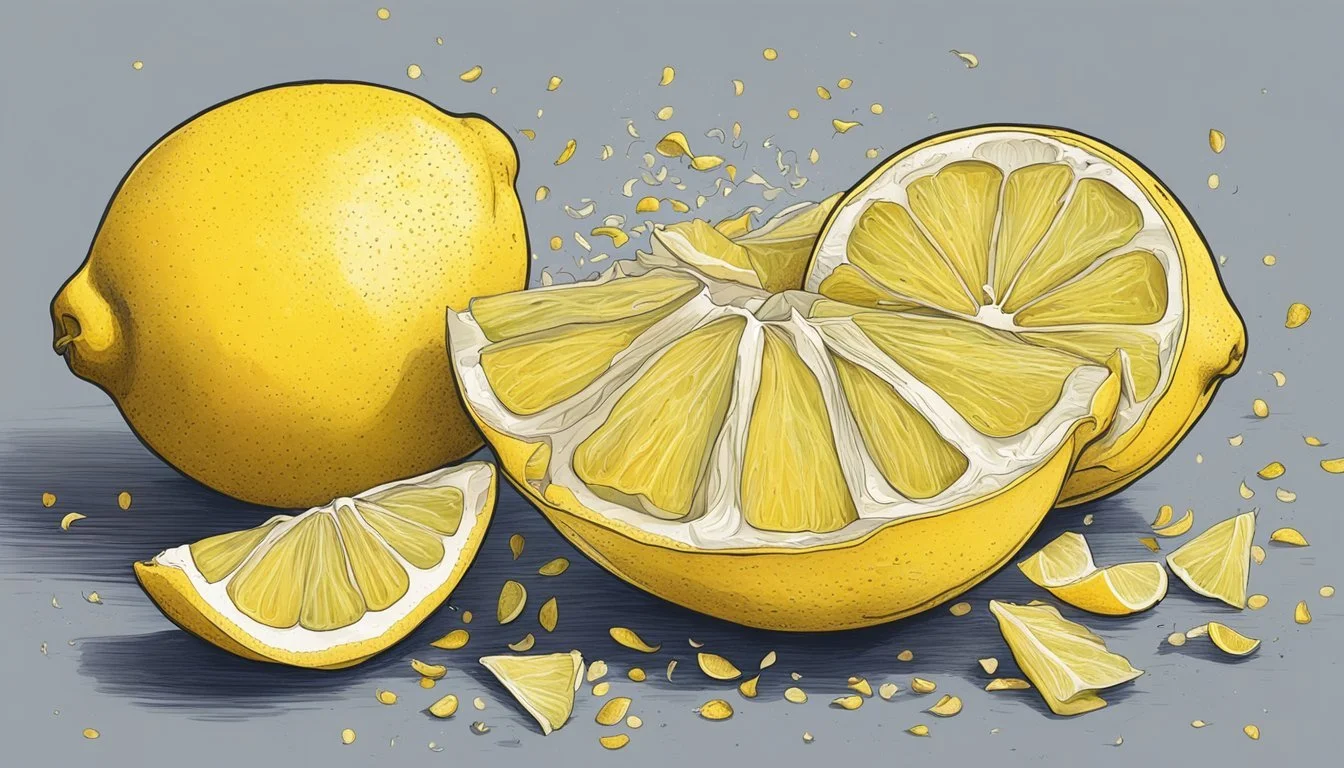How Long Does Lemon Zest Last?
Shelf Life and Storage Tips
Lemon zest, the vibrant outer peel of the lemon that contains the fruit's oils, is an integral ingredient adding bright citrus notes to a variety of dishes. Understanding the longevity and proper storage of lemon zest is essential for anyone looking to maximize its usage in their cooking endeavors. When stored correctly, lemon zest can remain flavorful and aromatic for significant periods. In the refrigerator, when placed in a resealable bag or an airtight container, zest can retain its properties for a few weeks.
The freezer extends the shelf life of lemon zest even further. Here, it can maintain quality for approximately 6 months to a year without losing much of its characteristic flavor. Furthermore, since there is no need to thaw frozen lemon zest before incorporating it into recipes, it provides a convenient, long-lasting option for culinary applications.
Preservation methods such as dehydration offer an alternative by removing moisture and thus keeping zest usable for extended periods. However, even though dehydration can extend the lifespan of lemon zest, it may alter its fresh taste to some degree. Nonetheless, whichever method chosen, the vitality of lemon zest in flavoring dishes makes understanding and implementing proper storage techniques worthwhile.
Understanding Lemon Zest
Lemon zest is a versatile ingredient that brings a burst of flavor to a wide array of dishes. This section clarifies what lemon zest is, how it compares to other citrus zests, and its various benefits and uses in cooking.
Defining Zest
Zest refers to the outermost layer of citrus fruits such as lemons, limes, and oranges. Specifically, lemon zest is the bright yellow part of the lemon peel, excluding the underlying white pith, which is bitter. This zest contains the fruit's essential oils, which contribute a concentrated citrus flavor without the acidity of lemon juice.
Lemon Zest vs. Other Citrus Zests
While lemon zest offers a distinct tart and tangy flavor, it is just one type of citrus zest. Lime zest tends to be more fragrant with a slightly floral note, and it's often used in tropical drinks and Thai cooking. Orange zest provides a sweeter, less acidic taste, making it ideal for desserts and sweet sauces. Each type of zest lends a different flavor profile to dishes, enhancing them in unique ways.
Health Benefits and Culinary Uses
Lemon zest not only adds a robust lemon flavor to food and drinks but also contributes nutritional benefits. It is rich in vitamin C and contains bioflavonoids that have antioxidant properties. As a culinary ingredient, lemon zest is used as a garnish, in desserts, baking, cocktails, sauces, salad dressings, and to flavor savory dishes. It is a versatile seasoning that can be used in place of or in addition to fresh lemon juice to impart citrus notes without additional liquid.
Here's a snapshot of lemon zest's applications across different culinary contexts:
Desserts: Enhances sweetness with a citrus note.
Baking: Integral in recipes for cakes, cookies, and pastries.
Cocktails: Adds aroma and a zesty twist to beverages.
Sauces/Salad Dressings: Infuses a bright, lemony flavor into liquid condiments.
Savory Dishes: Works as a fresh seasoning to elevate meats, vegetables, and grains.
Zesting Techniques
The art of zesting involves using the correct tools and techniques to extract the flavorful outer skin of a lemon without reaching the bitter white pith beneath. This section covers the essentials for effective zesting.
Proper Zesting Tools
When choosing kitchen tools for zesting, one's selection should be guided by efficiency and the intended zest outcome. A microplane offers fine, fluffy zest ideal for baking and cooking. In contrast, a citrus zester creates long, decorative strips for garnishing. A box grater with a zesting side or a cheese grater with small holes can also serve the purpose well. Furthermore, a vegetable peeler or a paring knife could be used carefully to create larger pieces of zest, though these tools require skill to avoid the pith.
How to Zest a Lemon
To properly zest a lemon, wash and dry the lemon first. Hold the lemon in one hand and your zesting tool in the other. If using a microplane or grater, gently rub the lemon in one direction against the blades. Rotate the lemon after each pass to only remove the bright yellow outer layer. For a vegetable peeler or knife, one should apply even pressure to peel off thin layers, being cautious to leave the pith behind.
Avoiding the Pith During Zesting
The white part of lemon, known as the pith, is bitter and undesirable in zest. It can overpower the fresh zest's vibrant flavor. Regardless of the tool employed, it's imperative to zest with a light hand and avoid grating too deeply. The color change from bright yellow to white is a clear indicator of when to stop. If using a vegetable peeler or a paring knife, visually monitor to keep the peeled strips pith-free.
Storing Lemon Zest
Proper storage of lemon zest can significantly extend its shelf life, whether for immediate use or future recipes. Below are the best methods to ensure zest remains fresh and flavorful.
Short-Term Storage Options
For short-term storage, one should keep lemon zest in an airtight container and place it in the refrigerator. Fresh zest typically lasts up to a week when stored correctly in the fridge.
Freezing Lemon Zest for Longevity
For long-term storage, freezing is ideal. When stored in the freezer, lemon zest maintains quality for approximately six months. Place the zest in a resealable bag or an airtight container before freezing to preserve its flavor and prevent freezer burn.
Unfrozen Zest: Refrigerator - Up to 1 week
Frozen Zest: Freezer - Up to 6 months
Best Practices in Zest Preservation
To optimize lemon zest preservation:
Ensure that containers are airtight.
Label containers with the date of storage.
Avoid including any of the bitter pith to maintain the quality of the zest.
Thawing frozen zest is not necessary before using it in recipes, as it can be used directly from the freezer.
By following these specific storage techniques, one can effectively store lemon zest to prolong its usable life.
Lemon Zest in Cooking
Lemon zest plays a multifaceted role in the culinary world, offering a concentrated burst of citrus flavor that enriches a diverse range of dishes. It is especially prized for its ability to add a hint of lemony brightness without the additional liquid that lemon juice provides.
Incorporating Zest into Recipes
Chefs often incorporate lemon zest into recipes to achieve a vibrant citrus note. In baking, the zest can be mixed into dough or batter to infuse baked goods with a subtle tartness, complementing both sweet and savory creations. When adding zest to desserts, it is important to finely grate it to ensure even distribution of flavor. For savory applications, such as enhancing dressings, spicing up chicken, or tossing through vegetables, lemon zest can be combined with herbs to create a balanced and aromatic seasoning.
Zest as a Flavor Enhancer
Lemon zest serves as a powerful flavor enhancer, capable of elevating the taste profile of many dishes. It introduces a zesty, citrus zing to sauces and dressings, making them more complex and refreshing. In cocktails, a sprinkle of zest can replace or complement lemon juice, giving a fragrant touch to the beverage. Additionally, lemon zest acts as a bright garnish for salads, soups, fish, and savory dishes, where its color and flavor contrast beautifully with the meal, without overpowering other components.
Creative Uses and Variations
Lemon zest, with its bright flavor and citrus scent, has a wide range of applications beyond typical recipes. It can transform simple ingredients into gourmet condiments and homemade products.
Zest-Based Condiments
Using lemon zest in condiments can elevate their flavor profile immensely. A fine grating of zest mixed into salad dressings not only infuses them with a fresh, lemony essence but also adds a burst of color. Additionally, one can craft a homemade lemon pepper seasoning by combining dried lemon zest with cracked black pepper and other spices. This zest-infused seasoning can be used as a versatile spice rub or to add a zing to marinades.
Salad Dressing Example:
3 parts olive oil
1 part lemon juice
1 tsp grated lemon zest
Salt and pepper to taste
Optional: herbs or garlic for extra flavor
Homemade Lemon Pepper Seasoning:
1 tbsp ground black pepper
1 tbsp dried lemon zest
½ tsp sea salt
½ tsp onion powder (how long does onion powder last?) (optional)
½ tsp garlic powder (optional)
Zest in Homemade Products
Lemon zest's suitability for homemade creations is not limited to the kitchen pantry. For instance, it is a delightful addition to baked goods such as lemon pound cake or lemon bars, where it adds depth and aromatic intensity to the desserts. Furthermore, enterprising individuals may use the zest to infuse spirits, creating their own version of limoncello, a traditional Italian lemon liqueur. The zest's essential oils impart a strong lemon flavor that is unmistakably natural and inviting.
Baking with Zest:
Incorporate into lemon pound cake batter for enhanced lemony notes.
Sprinkle atop lemon bars before baking for an extra citrus punch.
Limoncello Recipe Basics:
Infuse high-proof vodka with lemon zest.
Allow the zest to steep until the vodka takes on a strong lemon flavor.
Strain and combine with a simple syrup to taste.
Tips and Tricks for Lemon Zest
When preparing lemon zest, one aims to capture the intense lemon flavor without the accompanying bitterness from the pith. These tips and tricks will ensure maximum flavor and longevity in both prep time and use.
Enhancing Prep and Cook Time
Prep Time: Utilizing the right tool can significantly reduce prep time. A microplane grater is highly efficient for zest creation as it finely shreds the lemon peel, avoiding the bitter white pith beneath. Alternatively, a citrus zester can produce long strands quickly. The total time for zesting a lemon can be under a minute with these tools.
Cook Time: Adding lemon zest early in the cooking process can infuse the dish with a robust citrus flavor. However, for a more nuanced taste, introducing the zest during the final stages preserves its aromatic qualities.
Skills: Fine motor skills are beneficial when using a microplane or zester to minimize pressure and prevent pith inclusion.
Tricks: To avoid wastage and enhance grip, one can wrap the lemon in a paper towel before zesting.
Tool Advantage Tip Microplane Grater Fine zest, minimal pith inclusion Apply light pressure, move lemon gently. Citrus Zester Long, decorative strands Swift, downward strokes avoid the pith. Box Grater Multi-purpose tool Use smallest holes for zest; avoid pith.
Zest Substitutions and Alternatives
Substitute: When lemon zest isn’t available, alternatives like lime zest or orange zest can be used to impart a similar citrusy dimension, albeit with a different character.
Lemon Flavor: To mimic the zesty flavor, lemon juice can serve as a substitute, but should be used sparingly due to its acidity and potential for altering the consistency of the dish.
Substitute Equivalent Quantity Notes Lime Zest 1:1 replacement Similarly vibrant but slightly more tart. Orange Zest 1:1 replacement Sweeter, less tangy, and more fragrant. Lemon Juice Adjust to taste Incorporate gradually, mindful of acidity.
Other non-citrus alternatives include ginger for a different kind of zestiness, or garlic for pungency, but these vary significantly in flavor profile from lemon zest and should be chosen based on the desired end result of the dish.
Zest and Food Waste
Food waste can significantly be reduced by using the entirety of lemons, from juice to zest. Proper utilization of lemon zest does not only add flavor to dishes but can also diminish food waste.
Utilizing the Entire Lemon
When it comes to lemons, every part of the fruit is useful. Zest, which is the outer colored layer of citrus fruits, adds a concentrated flavor to a variety of recipes. Before juicing a lemon, one should zest the lemon to ensure that no part of the lemon goes to waste. This strategy aligns with food waste reduction goals by maximizing the use of every lemon purchased.
Most lemons come with a wax coating which is applied to preserve freshness. It's essential to wash the lemons thoroughly to remove this coating before zesting. Once zested, the lemon zest can be used immediately or stored properly to maintain its potent flavor. Here’s how to handle the zest efficiently:
Fresh Lemon Zest: Should be used within a few days and kept in the refrigerator in an airtight container.
Frozen Lemon Zest: Can last for up to a year when stored in a resealable bag or airtight container in the freezer.
By doing this, the zest remains available and ready to enhance future meals, reducing the need to purchase additional lemons and contributing to a decrease in food waste.





